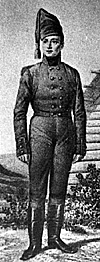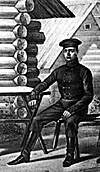If you have a problem, if no-one else can help, and if you can find them, you can ask the A(-ge) Team!
Benjamin Checota wrote to us with a series of questions on the Russian Army during the 1812 campaign. Rather than print the questions and throw them open to the readership, l passed Benjamin's letter to Laurence Spring of the Russian Study Group for his attention. The questions and Laurence's answers are below. Laurence has asked the members of the Group for further information, but if anyone has any additional comments, please feel free to write in.
There are several Study Groups available, covering areas like the Russian Army, the Austrian Army and the Honourable East India Company. If you would like to know more, please write to Paul Chamberlain c/o this magazine giving details of your interests. Please also include a SAE for each study group on which you want information.
Q.24.1 What Russian regiments had "reserve" battalions in 1812?
In November 1811 the Ministry of War ordered that the Recruit Depots should divide themselves up into four to six battalions of three companies to be known as Reserve (Rezernyi) or recruit (rekrutskii) battalions, these recruit or fourth battalions were allocated to every regiment within the 3rd to 26th Division, ie all the musketeer and Jager regiments, except the Kexholm regiment which was attached to the Imperial Guard. The 1st and 2nd Divisions, being grenadier regiments did not receive a fourth battalion.
Q.24.2 Which regiment's depot battalions were brigaded with reserve battalions?
In 1812, at least, only the second (Zapasnyi) and fourth battalions of the Yelets Regiment of 11 Division appear to have served together serving in the Mogilev province. On 14 March 1812 the second battalions were detached to form the 30 to 37 Divisions. These new Divisions did not include the battalion's grenadier company, which were to be formed into combined Grenadier battalions. The second battalions from the Life and Graf Arakcheev Grenadiers of 1 Division, those of 19 and 20 Divisions, which were garrisoning Georgia and the Caucasus and the
Kexholm Musketeers were not included in these formations. The fourth battalions were to form 38 to 47 Divisions.
On 15 March 1812 these new Divisions were assigned to their newly formed Reserve Armies, the 32, 33, 39 to 42 Divisions formed the 1 Reserve Army, 27, 34 to 37 Division the 2 Reserve Army and 43 to 47 Divisions the 3 Reserve or Observation Army.
Q.24.3 Were these reserve battalions considered a true fourth battalion to the existing regiments or were they independent battalions that were merely brigaded with the second battalions?
The fourth battalions were considered to be part of the regiment, and with the second battalion supplied replacements to the 1 and 3 battalions. After 1816 they appear to have been used as internal garrisons.
Q.24.4 Were they organised like the line battalions i.e with a grenadier/tirailleur company & musketeer companies?
Each fourth battalion had only three companies of recruits.
Q.24.5 What were the distinctions for the reserve battalions, was their uniform the same as the parent unit but with sequential distinctions as for the other three battalions Or did they have their own distinct uniform?
 According to A V Viskovatov's excellent work
Historical Description of the Clothing and Arms of the
Russian Army volume 13 pp.45 - 46 from
May 1808, a recruit wore a double breasted grey coat with
cloth covered buttons and without shoulder straps, grey
trousers, a grey forage cap without any distinction, black
books and a cravat and a grey cloth knapsack [see
photograph no.1 at right].
According to A V Viskovatov's excellent work
Historical Description of the Clothing and Arms of the
Russian Army volume 13 pp.45 - 46 from
May 1808, a recruit wore a double breasted grey coat with
cloth covered buttons and without shoulder straps, grey
trousers, a grey forage cap without any distinction, black
books and a cravat and a grey cloth knapsack [see
photograph no.1 at right].
Unfortunately the copy of Viskovatov's work available to me is the 1900 edition with black and white illustrations, the first edition having coloured ones.
 By examining the black and white illustration [see
photograph no. 2 at left] it would appear that the seated recruit is
wearing a darker coloured coat from the recruit in photo no.1,
possibly green, with the collar, cuff, and headband of the
forage cap possibly red. The coat has no shoulder straps or
any piping on the forage cap as a distinction. The recruit is
also wearing grey trousers and black boots.
By examining the black and white illustration [see
photograph no. 2 at left] it would appear that the seated recruit is
wearing a darker coloured coat from the recruit in photo no.1,
possibly green, with the collar, cuff, and headband of the
forage cap possibly red. The coat has no shoulder straps or
any piping on the forage cap as a distinction. The recruit is
also wearing grey trousers and black boots.
However this is just speculation without seeing the 1851 edition of Viskovatov's book. Certainly the change in the colour of their uniforms would fit their new status as being part of a regiment.
Back to Age of Napoleon No. 24 Table of Contents
Back to Age of Napoleon List of Issues
Back to MagWeb Master List of Magazines
© Copyright 1998 by Partizan Press.
This article appears in MagWeb (Magazine Web) on the Internet World Wide Web.
Other military history articles and gaming articles are available at http://www.magweb.com